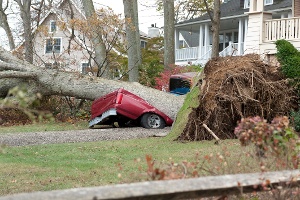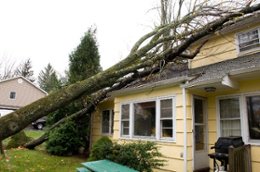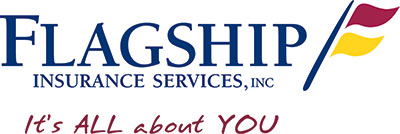
by Flagship Staff | Sep 11, 2018 | Blog
Last week’s blog identified areas of your property you should inspect after a severe storm. Some of those areas include roof, siding, outdoor structures, and fallen trees.
A common claim scenario that insureds deal with after a storm is fallen trees. High winds and saturated ground can create the perfect storm.
Earlier this summer, heavy storms rolled through my sister-in-law’s neighborhood. After the storm cleared, she inspected her property. What she found was a large branch from her tree extending into her neighbor’s yard. Initially, she assumed it would be her responsibility to file a claim with her insurance company to cover the damages and removal. She quickly learned that this is a complicated situation, which can cause intense arguments between once friendly neighbors.
Homeowners Insurance 101
A standard homeowners policy (basic form) typically protects you from the causes of loss (perils) listed below.
Fire and lightening
Smoke and explosions
Windstorms and hail
Volcanic eruptions
Falling objects (trees)
Theft or vandalism
Malicious mischief
Aircraft or vehicle damage
Snow, sleet, and ice
Below are some common questions and answers regarding how a standard homeowners policy may respond.
Q: If my tree falls and damages my home or property, is it covered?
A: Typically, a standard homeowners policy covers damage caused by a fallen tree if the cause of loss (peril) is wind. Covered property includes your home and other structures, such as a fence or shed. If a tree falls on your car and turns it into a Matchbox car, your auto policy will provide coverage if you have purchased comprehensive insurance.
Q: If my neighbor’s tree falls on my home or property is it covered?
A: This is a situation where your relationship with your neighbor can sour. If your neighbor’s tree falls on your property due to wind, you’re responsible for the cleanup and contacting your insurance company to see if there’s coverage for any damage sustained. If there’s coverage for the damage, you’re responsible for paying your deductible. The same would be true for your neighbors if your tree falls on their property.
This is where the conflict started with my sister-in-law and her neighbor. Her neighbors felt it was absurd that they had to pay for debris removal charges for a tree that wasn’t theirs. In some situations, neighbors will agree to split the debris removal charges as an act of good faith. Because this turned into an ugly situation, my sister-in-law paid for the tree removal.
Q: My neighbor caused the tree to fall, am I still responsible for damage?
A: If you can prove that your neighbor’s tree fell because it was diseased or dead and they didn’t do anything to prevent this, then they’d be responsible for your property damage due to negligence. In addition, if your neighbor cut down a tree and it fell and damaged your property, they would be responsible for that as well.
Q: Do I have coverage for debris removal?
A: Depending on your policy, you may have coverage. The basic homeowners policy could pay up to $500 for the removal of any one tree and up to $1,000 for any one loss. Unless stated differently in the policy, your homeowners deductible would apply for this type of loss.
Some policies might specify that the tree must have damaged a covered structure or is blocking a driveway in order for debris removal coverage to apply. Some policies could provide coverage for tree debris removal regardless of whether or not there’s other damage to property.
Q: Do I have coverage for damaged trees or shrubs?
A: Another portion of your policy could reveal coverage that would pay for damaged trees, shrubs, and other plants. It would list those perils for which coverage might apply.
So many variables can come into play when determining coverage. Review your policy with your agent; he or she will be able to answer any questions you have about your coverages, or they can check with the carrier on your behalf.

by Flagship Staff | Sep 4, 2018 | Blog
Severe weather can pop up in your neighborhood quickly. If severe weather strikes, your first priority should be taking cover and protecting your family. Unfortunately, the damage after severe weather can wreak havoc on your home and neighborhood. Common types of storm damage to your home can be caused by wind, water, or hail.
After the skies clear and you’ve been given the all clear by your local weather service, checking your home for damage should be your next priority. Protecting your home from further damage is critical. Here are some areas you should inspect.
1. Roof. Depending on the storm, roof damage can be significant. High winds can easily tear your shingles off. From the ground, look for missing shingles. If hail came through your area, depending on the size of the hailstones and other conditions, the damage may or may not be significant. Contact your insurance company. They will send out an expert who will be able to identify if you have damage. For more information, check out my blog “Your roof and your insurance rates.”
2. Siding. Depending on your siding, damage may be evident. Brick, stucco, and cement fiber siding are more durable than vinyl siding. No matter what siding type you have, walk around your home and check for damage. Damage can consist of cracks, chips, dents, and holes.
3. Outdoor structures. If you have a detached garage or shed don’t forget about them: especially if you’re storing tools, collector cars, or other types of equipment. Even a small hole or leak can damage what’s inside. If you find a hole, consider covering it with a tarp. If that isn’t possible, consider moving those items to prevent further damage. To learn if your outdoor structure is adequately insured, click here.
4. Electronics. A lightning strike or power surge can damage or destroy your expensive electronics.
5. Fallen trees or limbs. Understanding coverage for fallen trees can be a bit tricky. Do you have coverage for the tree itself, debris removal, or coverage for your neighbor’s fallen tree on your property? Contact your agent to find out.
6. Miscellaneous property. Other items to look at include:
Air-conditioning unit;
Fence;
Patio/deck furniture; and
Cars parked in your driveway.
7. Basement. Significant rainfall can be difficult on your sump pump and local sewer system. Check the area around your sump and floor drain. To learn how to keep your sump pump in good working order click here. If you don’t have water backup or sump pump overflow coverage on your policy, talk to your independent insurance agent to learn more.
For a list of helpful reminders, checkout the infographic below!
Miscellaneous Safety Tips
If you have overhead powerlines in your neighborhood, be cautious when inspecting your property. High wind or trees could have knocked them down.
Keep your kids out of flooded streets and rushing water. Dangerous situations that weren’t there before may now be present.
Only consume food or water that was not damaged by the storm.
If your home has been damaged, consider turning off your main utilities, including your natural gas, electricity, and water main.
Before a severe storm hits, consider documenting your possessions. Whether you rent an apartment or own a home, one of the most important things you can do is to keep an inventory of your personal belongings. Trying to remember what you own after a disaster strikes can be overwhelming.
Insurance policies are not created equal! More than likely, your policy is different from your neighbor’s policy. Depending on the storm and the type of damage you experience, you may or may not have insurance coverage to help get you back on your feet. This can make a devastating situation even worse. If you aren’t familiar with what your policy covers, please contact your independent insurance agent.

by Flagship Staff | Aug 28, 2018 | Blog
In just a few short days, our children’s alarm clocks will be ringing and hectic school schedules will become a part of our routine.
No matter what age your child is, the first day of school can cause anxiety for the entire family. Here are some things you can do to make the first day a bit less stressful for everyone.
1. Fill their backpacks ahead of time. While I didn’t always enjoy school, I did enjoy looking at my new school supplies. A few days before school starts, lay out your children’s supplies. Next, double check their supply lists to make sure you’ve bought everything they need and then start filling. This could be an enjoyable activity for all of you.
2. Lay out their clothes. I know this seems like a “no-brainer”, especially on the first day of school because they probably have new outfits to wear. The challenge is to keep this as part of your routine as the school year progresses and this begins to feel more cumbersome. If you have teenagers, good luck!
3. Pack their lunches the night before. My wife does a great job packing our lunches the night before. It saves everybody so much time in the morning. The only issue I have occasionally is when I get the text, “Dad, I forgot my lunch. Can you drop it off at school?” Ugh, luckily it doesn’t happen often.
4. Complete additional paperwork. While most of the paperwork should already be on file with the school, consider completing additional paperwork a few days prior or the night before. Returning additional paperwork on the first day of school can be beneficial to you because you can cross it off your “To-Do” list.
5. Designate a departure time. It’s inevitable that the morning routine won’t go as planned. Let your kids know the night before when you’ll be leaving. Don’t forget to build in a five to seven minute cushion to allow for extra traffic or the missing gym shoe.
6. Get a jump-start on course work. If you have a high school or college student, it may be a good idea to have them start doing some reading or other work a few nights before school starts. This can help eliminate some of the pressure that accompanies the first few days of school. My daughter in college has been working on course work for about a week.
7. Check out the bus stop. If your child is riding the bus for their first time, consider taking a walk or bike ride to your neighborhood bus stop. This will help familiarize your child with its location and surroundings.
8. Set several alarms. If your kids started going to bed at an earlier time a week or so prior to school, you’re probably a step ahead of the rest of us. If you have a teenager like me, that plan doesn’t work. Therefore, I’ll have her set her alarm so when my wife or I go into her room to wake her, she is already stimulated.
9. Set a reasonable bedtime. Excitement and a late night summer routine can make it difficult for your kids to go to bed the night before school starts. Consider compromising on the bedtime the first few nights until their bodies adjust to the school routine. Don’t forget that it’s important they get plenty of sleep. Depending on their age, they may need eight to thirteen hours of sleep per night.
I hope your child’s first day goes great!

by Flagship Staff | Aug 21, 2018 | Blog
Going on vacation with your family can be exciting, but it can also involve a lot of planning, depending on where you’re going. While vacations can be busy, they usually offer much needed rest and relaxation.
When preparing for a vacation, the last thing you want to think about is coming back home to your everyday routine. To help extend your rest and relaxation a bit further, here are some things to consider before you go and after you come back.
1. Create a checklist. Create a checklist that identifies what you want to accomplish before, during, and after the vacation. This can help reduce feeling overwhelmed and can serve as a sense of accomplishment when you cross things off your list.
2. Have your family immediately unpack. We’ve been fortunate to take numerous vacations as a family, so we all know the drill. When we arrive home, the first thing my wife wants us to do is unpack our suitcases. Each one of us is responsible for putting our travel items away and taking our dirty clothes to the laundry room. While we complain about this, it helps avoid a cluttered house, which can be overwhelming.
3. Extra R&R days. My wife does a great job planning our family vacations. Part of her plan always includes returning home a day or two early. This allows us to catch up on sleep and other tasks before returning to work or school. Also, you never know when travel delays may occur. This helps alleviate some of the stress accompanied with returning home.
4. Return to a clean house. Before we leave on vacation, my wife insists on cleaning our house from top to bottom. Again, more grumbling from the peanut gallery. However, I must admit returning to a clean house does feel great after spending time in other accommodations. You know the old saying, “There’s no place like home.”
5. Stock the kitchen cupboards. Travel days can be long and tiring. For me, there’s nothing worse than coming home to empty cupboards. Consider buying non-perishable food items before you go so that when you return, you don’t have to go to the grocery store immediately. Another option is to ask family or friends to grocery shop for you so that when you get back your refrigerator and cupboards are full.
6. Talk about the positives of returning home. Returning home after a memorable vacation is always difficult. Let’s face it; it’s hard to beat not having to follow schedules or daily routines. After our most recent European vacation, I was happy to return home. Talk to your family about the positives of returning home. Positives may include:
A quiet neighborhood;
Sleeping in your own bed;
Spending time with your pet(s);
Visiting with family and friends; and
Not having to use public transportation.
7. Don’t forget a souvenir. Souvenirs are a great way to help remember your trip. Depending on what it is, you may be able to integrate it into your daily life. Sweatshirts, a statue of the Eiffel Tower, and chocolate have helped my family enjoy our trips a bit longer!
8. Talk about next year’s trip. Before your vacation ends, talk about where you want to go next year. Thinking about your future trip helps ease the thought of going back to your daily life. While all good things must end, it’s nice to think about what the future may hold.
9. Reminisce with your family. Set aside some time to look at your photos or videos from your vacation. Everybody in my family has a smartphone, so it’s nice to see all the different pictures that my kids take while we’re on vacation. It’s also a great way to see things you’ve missed!
10. Exercise. Returning home after vacation can you leave you feeling sluggish. Delicious food, increased alcohol consumption, late-night dinners, and busy days can catch up with you. While exercising may not be high on your priority list, it’s a great way to get the endorphins flowing, improving your mood.
11. Catch up on your sleep. Depending on your vacation, sightseeing and other adventures can lead to hectic schedules and late nights. Make sure to get seven to eight hours of sleep when you return home. Proper sleep helps your body recover and boosts your energy and productivity levels.

by Flagship Staff | Aug 14, 2018 | Blog
One frequently-asked question we receive from our policyholders and agents is: Are rented vehicles covered by the personal auto policy?
While the most common scenario is renting a private passenger vehicle while on vacation, this also applies to renting a moving truck or a motorhome for personal use.
Amy Justman, senior personal lines underwriter will explain the difference between a standard policy and a West Bend Home and Highway® policy.
The standard policy language developed by Insurance Services Office (ISO) and used by many personal auto companies provides coverage for rented vehicles under PART D – COVERAGE FOR DAMAGE TO YOUR AUTO. This, however, can be limiting as it only covers damage identified as “collision” and other-than-“collision” and a deductible will often apply. There may also be limits to the type of vehicle covered.
West Bend’s Home and Highway policy, on the other hand, includes rented vehicle coverage under PART A – LIABILITY COVERAGE. This allows us to cover any damages for which you’re found legally liable – including those assumed via contract (aka the rental agreement) – up to the limit of liability. Additionally, under liability coverage, there’s no deductible. The liability coverage automatically applies to four-wheel vehicles licensed for road use when rented for personal use.
This is a feature we call out as especially unique to our Home and Highway policy because of the broad coverage. Again, all insurance providers and their coverage forms differ so make sure to contact your agent or company to confirm before signing the liability waiver and driving off!
These questions are also often part of the discussion. The answers are specific to coverage provided by the Home and Highway policy:
1. Who’s covered for rented car coverage?
The “insured” and a “family member” as defined by the personal auto coverage form.
2. Is there a coverage territory for rented car coverage?
Yes, the coverage territory is:
1. The United States of America, its territories or possessions
2. Puerto Rico
3. Canada
3. Is there a limit to the amount of coverage West Bend will pay on a covered loss to a rented car?
Yes, the Property Damage or Combined Single limit is the total amount we’ll pay for damages to the rented car.
4. Will West Bend pay for loss of use to a rental car company?
After a loss, our Claims Department will investigate to determine if the rental car company did indeed suffer a loss of use due to damage to the rented car; we will only pay if warranted. If we find there were other fleet vehicles available for rent while the damaged vehicle was being repaired, there was no loss of use. In that case, we’ll deny this portion of the claim. If they can validate they experienced loss of use, we’ll provide coverage for a reasonable period. For example, replacing a windshield shouldn’t take more than a day.
5. My Home and Highway includes a Personal Umbrella. Will that limit be available as excess over and above the underlying auto liability limit?
Yes, the Umbrella limit will provide excess limits beyond the underlying auto Property Damage or Combined Single limit.
Furthermore, because the coverage territory for the Umbrella is worldwide, it would provide coverage even if needed outside the auto coverage territory described above. In such an event, a $250 retention (deductible) would apply.





